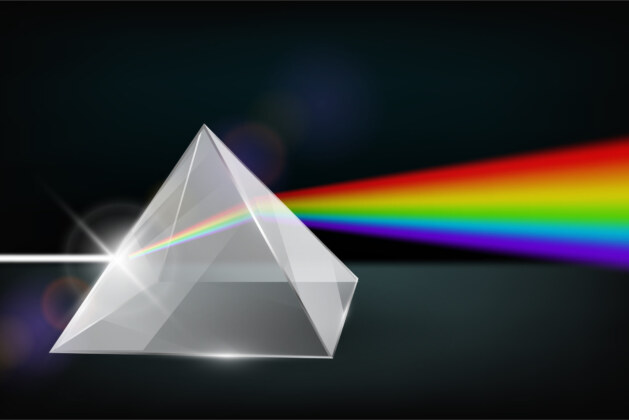Ever wondered why a prism can create a rainbow from plain white light? This fascinating effect isn’t just a magic trick—it’s rooted in physics. In this article, we’ll explore how it split white light into a spectrum of colors, what’s happening inside the glass, and why this natural phenomenon has both scientific importance and real-world applications.
Table of Contents
Introduction
A simple triangular piece of glass can produce one of nature’s most beautiful sights—a rainbow of colors. You’ve probably seen this in science class or as part of a cool physics demonstration. But how does it work? How can a single beam of white light turn into red, orange, yellow, green, blue, indigo, and violet?
The answer lies in the way light behaves when it travels through different materials. The process is called refraction, and when light passes through a prism, this bending leads to something truly amazing: dispersion, the separation of light into different wavelengths or colors.
What Is White Light?
Before diving into how it works, let’s understand what white light really is. White light isn’t just one color—it’s actually made up of many colors combined. When you see sunlight, for example, you’re actually seeing all the visible colors mixed together. This spectrum includes:
- Red
- Orange
- Yellow
- Green
- Blue
- Indigo
- Violet
These are often remembered by the acronym ROYGBIV.
The Role of a Prism
It is a transparent object, usually made of glass or plastic, that has flat, polished surfaces. The classic prism is shaped like a triangle, but what makes it special isn’t the shape—it’s how it bends light.
When white light enters a prism, something interesting happens: the light slows down and changes direction. This is due to refraction—a physical phenomenon that occurs when light moves from one medium to another (in this case, from air to glass).
Refraction: Why Light Bends
Light travels at different speeds in different materials. In air, it travels very fast, but in denser materials like glass, it slows down. When the light enters the prism, the change in speed causes it to bend. This bending is not the same for all wavelengths (colors) of light.
- Red light bends the least because it has the longest wavelength.
- Violet light bends the most because it has the shortest wavelength.
This variation in bending causes the different colors to spread out or disperse, forming a spectrum.
Dispersion: The Science of Color Separation
This separation of white light into its component colors is called dispersion. It happens because each color in white light has a different wavelength, and each wavelength bends at a slightly different angle when passing through it.
Inside the prism:
- Each color is refracted at a different degree.
- The colors spread out into a fan-shaped pattern.
- As the light exits the prism, the colors emerge at different angles, creating the full visible spectrum.
This is the same principle behind natural rainbows—light is refracted and dispersed in raindrops, which act like tiny prisms.
Real-Life Examples and Applications
Understanding how light behaves in a prism isn’t just academic—it has many real-world uses:
- Spectroscopy: Scientists use it to study the composition of stars and chemicals based on how they emit or absorb different wavelengths.
- Optics and Photography: Camera lenses and binoculars use prisms to direct light precisely.
- Telecommunications: Fiber optic systems rely on light refraction and dispersion for fast internet and data transmission.
- Art and Design: Knowing how light disperses helps artists and designers work with lighting and color effects.
Fun Fact: Isaac Newton and the Prism
The famous scientist Sir Isaac Newton was the first to show that white light is composed of different colors. In the 1660s, he used a prism to demonstrate that light isn’t colored by the glass but rather is split into colors it already contains.
He even used a second prism to combine the colors back into white light, proving that the spectrum wasn’t created by the prism—it was simply revealed.
Conclusion
Prisms might look like simple glass objects, but they reveal one of the most incredible truths about light: that it holds all the colors of the rainbow within. By slowing down and bending light, a prism uncovers the full beauty of the visible spectrum. Understanding this process gives us a deeper appreciation for the science behind everyday phenomena, from rainbows in the sky to advanced technologies in our lives.
Whether you’re a student, a science lover, or just someone curious about how the world works, the prism is a perfect example of how a small object can reveal something truly profound.
Read More: Power System Optimization: Strategies for Enhancing Efficiency and Reliability in Electrical Grids




